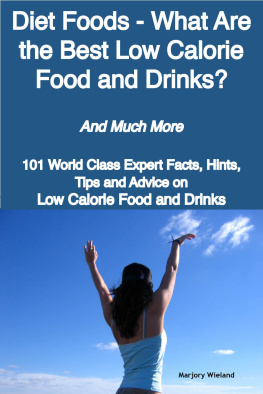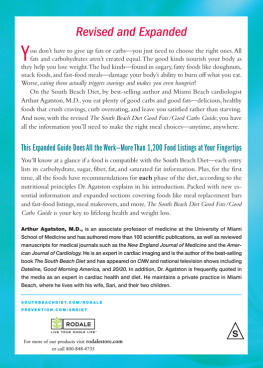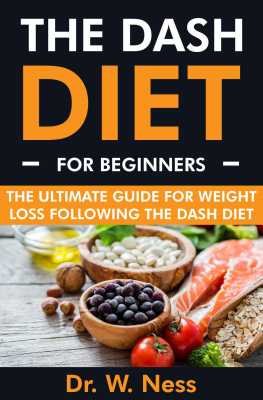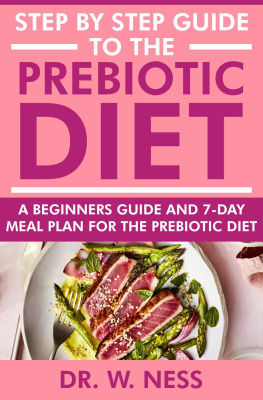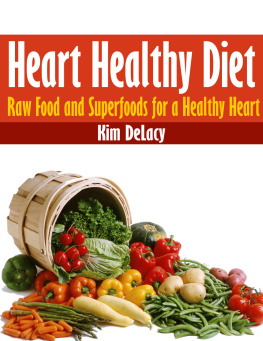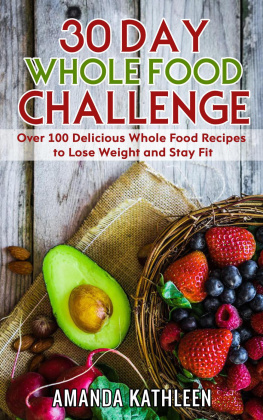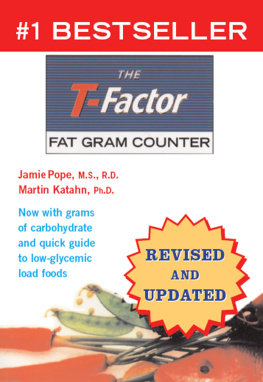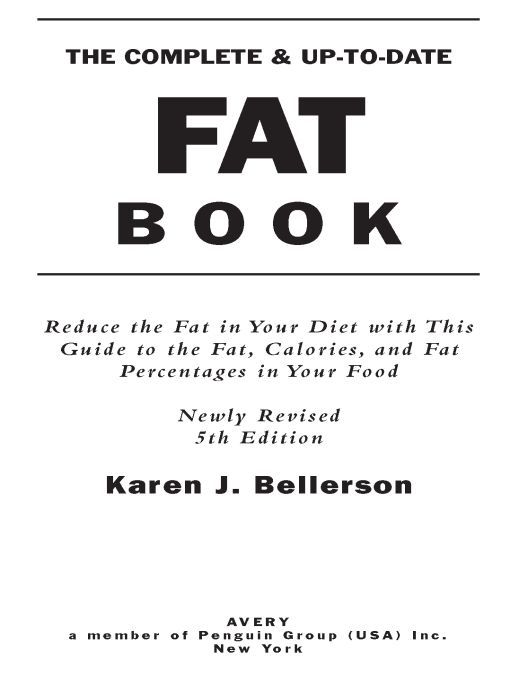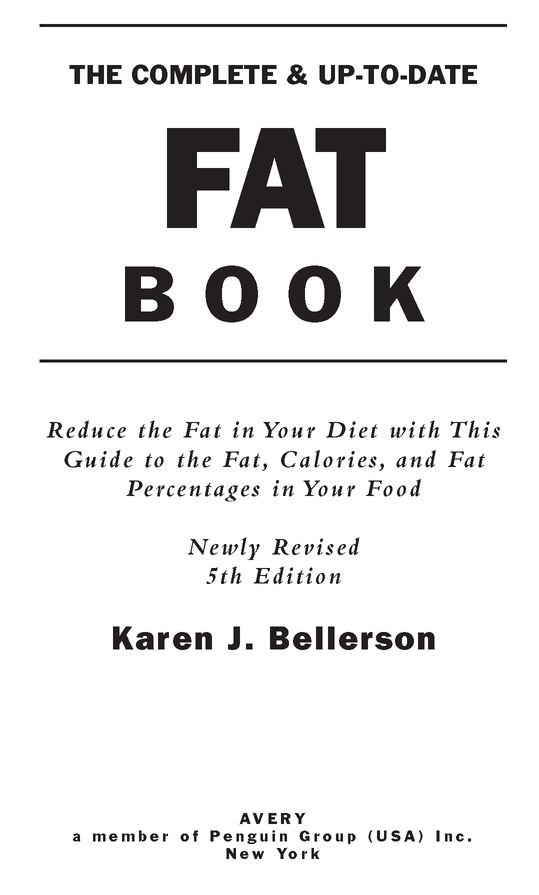Table of Contents
In memory of my beloved sister...
Valerie Dee Rushing
1952-2003
... always a piece of my heart
Acknowledgments
As always, my appreciation goes to those food manufacturers who make nutritional information about their products available and who have listened to consumers requests for tastier healthful food choices.
For all of you who take the time to write me (whether to ask questions, make comments, or offer suggestions), I want you to know that your letters are of great help to me. Thank you very much for allowing me to play a small part in your endeavors to pursue a healthier, nutritionally sound lifestyle.
Preface
Look to your health; and if you have it, praise God. Value it next to a good conscience; for health is the second blessing that we mortals are capable of; a blessing that money cannot buy!Unknown
Hello, and thank you, once again, for joining me in our never-ending quest for healthy eating habits. So much has happened since the last edition of The Complete & Up-to-Date Fat Book. We have endured much tragedy in our country, with 9/11, the war in Iraq, and ongoing unrest, not only here in the United States of America but throughout the world. We have become a stronger, closer-than-ever nation in facing those who wish us harm. We celebrated the 2004 Olympics, awash with athletic excellence and victories. Baseball fans celebrated an incredible World Series, in which the Boston Red Sox were unstoppable in their quest to go home to Boston with a World Series trophy! As I began this most current revision, we were in the process of electing yet another president of the United States. Now, two years later, this edition nears completion. I remain in awe of what wonders the future has in store for all of us. Life goes on.... Life is good.... Life can be great!
What also continues is my desire to bring you the most complete and up-to-date nutritional data available.With that goal in mind, I continue to educate not only you but myself as well. By this I mean that the constantly changing food industry keeps me on my toes with its ingenuity in manufacturing new food products. It is an endless challenge, which I gladly accept, to keep up with the extraordinary abundance of food products making their debut on our grocery shelves.
Many food manufacturers, along with nutritional watchdogs such as the Center for Science in the Public Interest, the National Cancer Institute, the American Heart Association, and the publishers of numerous nutrition and health newsletters, take our nutritional habits very seriously. They persevere in proving the direct relationship between a high-fat diet (in which more than 30 percent of daily calories comes from fat) and a higher risk of developing cancer, heart disease, stroke, diabetes, high blood pressure (hypertension), and other life-threatening diseases.Along these same lines, professionals throughout the health field promote the very real health benefits of a low-fat nutritional lifestyle.
In their endeavors to bring their findings to the publics attention, some of these groups publish dietary guidelines, which seem almost to be clones of one another. I offer you the guidelines of one such group, the National Cancer Institute.They are geared to cancer prevention, but they are consistent with the Dietary Guidelines for Americans below.
NATIONAL CANCER INSTITUTE DIETARY GUIDELINES
Reduce daily fat intake to 30 percent of calories or less.
Increase fiber to 20 -30 grams/day, with an upper limit of 35 grams.
Include a variety of fruits and vegetables in the daily diet.
Avoid obesity.
Consume alcoholic beverages in moderation, if at all.
Minimize consumption of salt-cured, salt-pickled, and smoked foods.
As much as I agree with the recommendations of the National Cancer Institute, there is one that is, sadly, missing from this list and others published in this country. I am referring to the proven fact that healthful eating habits encompass more than just sustained physical well-being, and involve more than just what you eat. The following recommendations, found in published dietary guidelines from some other countries, reinforce that fact:Britains number one dietary guideline is Enjoy your food.
Japanese dietary advice includes Avoid too much salt, and furthermore: Happy eating makes for happy family life. Sit down and eat together and talk.Treasure family taste and home cooking.
The Norwegian government tells its people that food and joy equal health.
Vietnam advocates preparing a healthy family meal that is delicious and serving it with affection.
As charming as the above advice is, it also makes perfect sense. Why? As you will find, following it often leads to a welcome bonus of more harmony within the family circle.And those of you who have teenagers may very well enjoy a double bonus by following any of these guidelines. Research strongly indicates that teenagers who eat with adult family members an average of five times a week tend to be more mentally alert, more motivated to do well in school, and less likely to use drugs or experience depression than those who eat with their parent/parents only three times a week or less.
As you read this book and plan your meals, keep in mind that it is your total diet that counts, not the nutrient content of a single food. Educating yourself in how much and what kind of dietary fat is in the foods you eat will enable you to make wise choices and keep your eating habits balanced and in moderation to make room for all your favorite foods. Remember, too, that small, gradual changes can add up to lifelong eating habits. Choose foods that fit in with your personal tastes and preferences, balancing good nutrition, variety, and great taste!
I wish you health, I wish you happiness, I wish all of us peace.
Until next time,
Introduction
Only saturated fats and dietary cholesterol raise blood cholesterol. A high level of cholesterol in the blood is a major risk factor for coronary heart disease, which leads to heart attack.American Heart Association
The single most influential dietary change one can make to lower the risk of these diseases [cardiovascular disease, diabetes, and certain forms of cancer] is to reduce intake of foods high in fats and to increase the intake of foods high in complex carbohydrates and fiber.
The Surgeon Generals Report on Nutrition and Health, 1988
More than half of all adults in the United States are overweight or obese, and the rates of obesity in children and teens have doubled since the late 1970s. Obesity increases the risk of diabetes, heart disease, stroke, and other health problems. Each year in this country, obesity causes tens or even hundreds of thousands of premature deaths, and costs the public tens of billions of dollars.
Centers for Disease Control and Prevention
Health specialists are calling it a fat epidemic, and no wonder, with the latest numbers showing that more than half of Americans are overweight and one out of three adults is obese. The fat-and-fatter trend has initiated more research into obesity than ever, focusing on its causes and effects. This is especially significant in light of findings that link higher fat intake to a myriad of serious health problems, including heart and respiratory disease, diabetes, osteoarthritis, and some forms of cancer.


